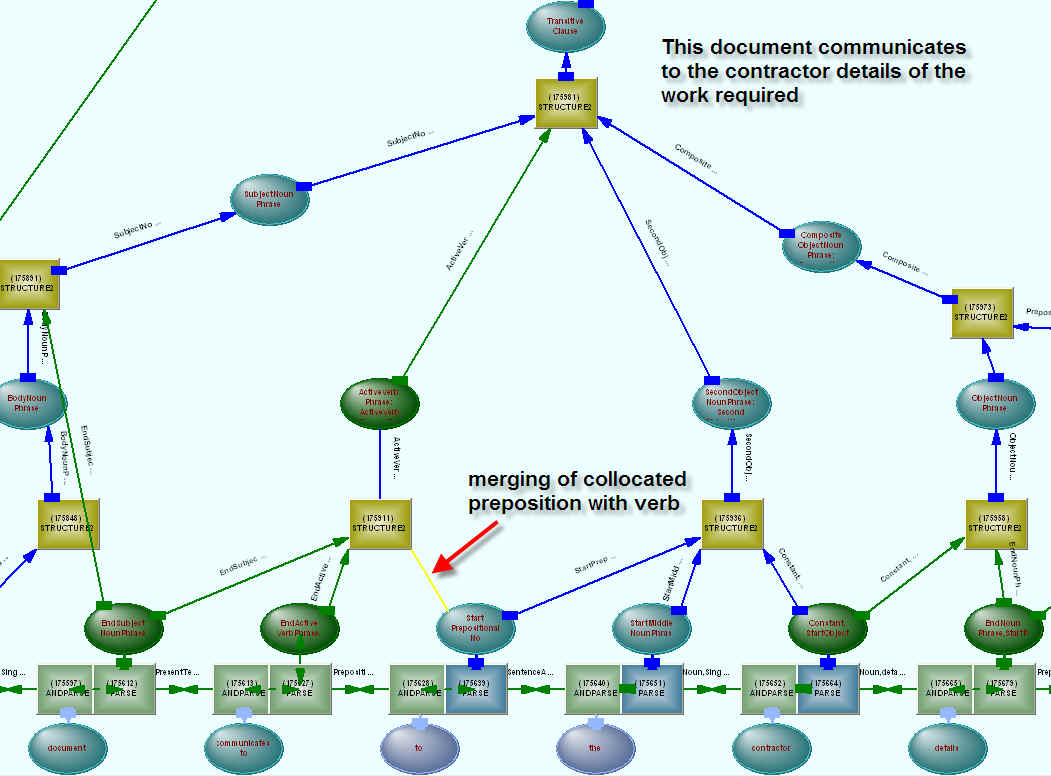
A Statement of Work (SOW) uses a different style to an FPS – more descriptive, although still clipped. It reinforces the need for a look ahead, or carry forward, mechanism.
Example 1:
This document communicates to the contractor details of the work required.
An active verb phrase is followed by a prepositional reference, and then the verb object – the semantics of the verb need to be used to disentangle the two. The punctuation can vary among
This document communicates to the contractor details of the work required.
This document communicates to the contractor, details of the work required.
This document communicates, to the contractor, details of the work required.
We can't asssume contractor and details are always separate objects -
He wanted the contractor details immediately
The purpose of putting the prepositional reference first is to allow the verb object to be long and involved, and not have the prepositional reference hidden away in a prepositional chain.

The second object noun phrase is built with the collocation, so it precedes the object noun phrase, and the clause pattern has to recognise this.
We can make the object noun phrase a little harder to see
This document communicates to the contractor on the project details of the work required.
If we have an active verb phrase without an object noun phrase, we need to examine the following noun phrases to see if they should be pulled apart - the "communicates" relation becomes active and puts out a tentacle.
However, the simple prepositional reference can become long and tortuous itself, as
This document communicates to the contractor involved in the agreement following the discussion which began last week, details of the work required.
For an example like this (perhaps a little extreme), we have no choice but to set up a carry forward mechanism. Can we assume we will get a comma when the chain is long? For the moment, we will assume a comma if more than one step, unless the break is obvious.
Example 2:
It enables communications between vehicles, including trams and trains, and home base.
"Between" requires an "and", unless it is followed by a plural noun (which it is here). "Including" can begin a list, ended by an "and". The last "and" in the sentence has no other home but either of "between" or including". We have to tolerate nesting within our carry forward. The chain can also include local "ands", as
It enables communications between vehicles, including trams from Dorrigo and Bentley, and trains, and home base.
We need to look back for homes for the conjunctions we find in lists, or carry forward the possibility.
Example 3:
This document describes the effort to be supplied to provide information.
"Effort" is an infinitive noun – it can be followed by an infinitive, which it grabs, forming the structure:
"(someone makes) the effort to do something"
where someone is the subject of "to do something"
Here it is followed by two infinitives, the first of which is participial – that is,
"the effort (that is) to be supplied"
where the infinitive refers to "effort", not the person making the effort.
Not all passive infinitives will be participial:
"the effort to be liked was tiring"
Here, "someone is making the effort to be liked", the "effort" isn’t trying to be liked.
Not only does "effort" grab an infinitive, it grabs only a certain kind.
We can make up a table of objects that expect certain following objects:
| Initial object | Following object(s) |
| Active transitive verb phrase | Clause object |
| Active ditransitive verb phrase | Clause object Clause object |
| Active transinfinitive verb phrase | Clause object Infinitive |
| Active clausal verb phrase | Clause |
| Active transclausal verb phrase | Clause object Clause |
| Passive ditransitive verb phrase | Clause object |
| Passive transinfinitive verb phrase | Infinitive |
| Passive transclausal verb phrase | Clause |
| Infinitive noun (effort, ability) | Infinitive |
| Clausal noun (expectation) | Clause |
| Between | And coordinate phrase |
| Either | Or coordinate phrase |
| List starter (including, namely) | Coordinate phrase |
| Object noun phrase | Modifier (prepositional, participial, relative pronoun) |
| Relative pronoun phrase | Internal clause terminator |
| Clausal pronoun phrase | Clause terminator |
| Subordinate clausal phrase | Clause terminator |
If the following object follows immediately, nothing need be done. If a preposition turns out to be a collocation of the verb, so the following noun phrase becomes the object noun phrase, nothing need be done.